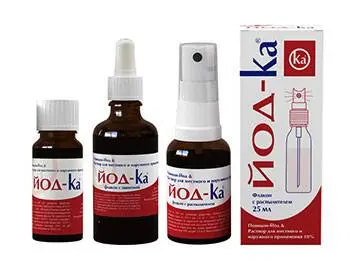Contents
Tomatoes or tomatoes are grown by all vegetable growers. This vegetable is valued for its taste and health benefits. They are grown in open ground and greenhouses. Unfortunately, the hopes of gardeners for a rich harvest of tomatoes are not always justified. This is due to plant diseases. One of the most insidious is late blight of tomatoes. If you do not start the fight against the disease in a timely manner, you can forget about the harvest. Not only beginners, but also experienced gardeners are interested in how tomatoes are processed from late blight and by what means.
Gardeners about phytophthora
Before talking about the processing of tomatoes from phytophthora, you must first find out what kind of disease it is, by what signs to distinguish it.
What is Phytophthora
Phytophthora (late blight) is a fungal disease, most often it can be seen on nightshade crops, such as potatoes and tomatoes. There are a huge number of varieties of the disease. Phytophthora is fully consistent with its Greek translation, destroys and destroys plants. Optionally, the soil of your particular garden can be infected with phytophthora: it can fly over from a neighboring site.
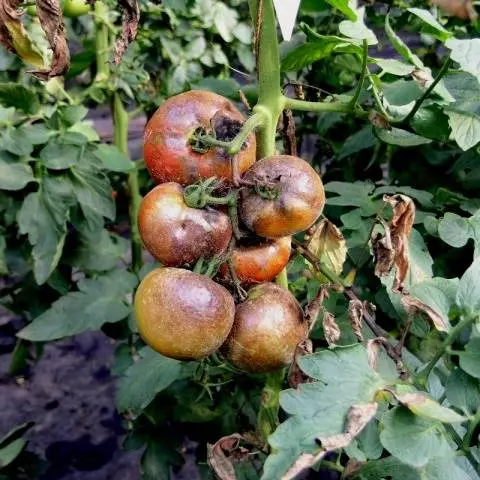
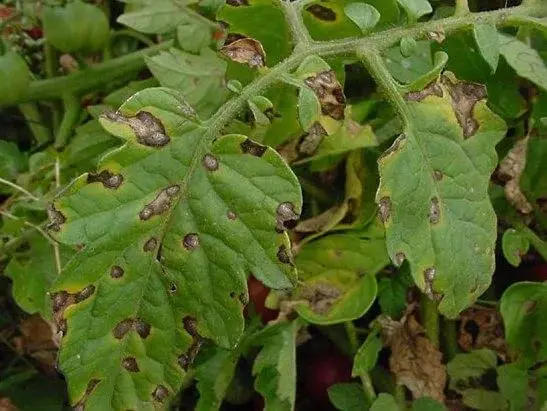
The disease develops rapidly, if it is not prevented, then it is able to destroy the entire crop of tomatoes. It appears on all parts of the plant. On green leaves, stems, and subsequently on fruits, brown spots appear, similar to a burn.
Causes
Why late blight develops on tomatoes and other nightshade crops:
- Summer residents deoxidize the soil by adding lime to them. Phytophthora fungus likes to settle and multiply on limed soils.
- The reason for the development is the thickening of the landings. Air circulation in this case is difficult, moisture accumulates in large quantities. Phytophthora spores are lovers of high humidity.
- Another reason is temperature fluctuations. As a rule, the peak of phytophthora development occurs at the end of summer. Tomatoes growing outdoors are especially affected. The sun burns them during the day, and cold dew falls at night.
- Plants that have good immunity rarely get sick. But weakened plants rarely manage to avoid late blight.
Symptoms of the disease
Even a novice gardener is able to determine the presence of a disease, because the symptoms are pronounced. The main thing is to appreciate your work and inspect planting tomatoes from time to time.
How to diagnose late blight:
- Whitish or brownish spots appear on the bottom of the leaves. Very quickly, the leaves turn brown, begin to dry out.
- Dark spots cover the stems. Blackened shoots are not able to nourish the plant, it becomes weak.
- If you do not declare a fight against phytophthora, the fungus will pass to the fruits and continue to multiply.
preventive measures
It is necessary to prevent the appearance of phytophthora at the stage of growing seedlings when processing soil, containers and seeds. Unfortunately, it is not always possible to completely eliminate the fungus.
The soil must be treated with Fitosporin-M. The best option is a complete replacement of the substrate. The remaining seedlings, even if there are no spots on it, are treated with the same Fitosporin or other means.
The second time, as a preventive measure, tomato seedlings are treated from phytophthora after planting in the ground. It is necessary to monitor the condition of the plants constantly.
Even if the plants do not get sick, preventive measures will not interfere.
How are tomatoes processed?
Today, the market is represented by a large number of drugs to combat phytophthora. Every year the range of chemicals is expanding. Unfortunately, dealing with adversity is not so easy. Phytophthora quickly gets used to the means for processing, if they are used constantly. At the slightest sign of illness, it is urgent to start processing tomatoes from phytophthora.
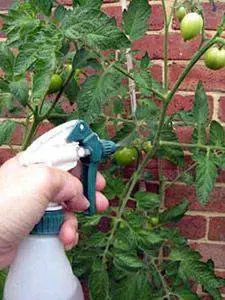
Chemicals
Processing of tomatoes from phytophthora is carried out with chemicals, since they are the most effective.
What tools can be used:
- Previkura and Fundazol;
- Phytosporinoma and Quadrisom;
- Ridomylos and Switch;
- Soon and Topaz;
- Horus and Fundazim;
- Thiovit Jet and Hom;
- Bordeaux liquid and blue vitriol;
- Copper oxychloride, Trichopolum and other means.
As you can see, the list is quite large. Before choosing a remedy for phytophthora, you need to carefully read the instructions. In addition, the processing must be carried out with the use of protective equipment. We will not discuss chemicals. And let’s talk about safe for humans.
Trichopol for processing
Many gardeners use drugs that can be purchased at a pharmacy. One of the pharmaceutical antimicrobial agents Trichopolum (Metronidazole). They began to use it not so long ago, but found its place in the arsenal of the fight against late blight. Why be surprised, since it helps a person, it means that it will help a plant, because it is also a living being.
What are the benefits of the drug:
- Trichopol is inexpensive, but its effectiveness in processing tomatoes from late blight has been tested by experienced gardeners: the drug was highly appreciated.
- This is not a chemical preparation, therefore, destroying late blight spores, it does not remain in the fruit, it is safe for humans.
- Processing of tomatoes can be carried out before harvesting. Vegetables are washed with running water and can be eaten.
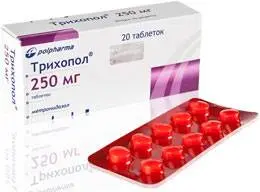
And now let’s figure out how to use Trichopolum. A pack of tablets (20 pieces) must be crushed and dissolved in 10 liters of water. Pour into a sprayer and thoroughly process the tomatoes, from all sides, without missing a single centimeter. This treatment of plants must be repeated after ten days.
Iodine is a faithful assistant
No matter how good Trichopolum was for treating tomatoes from phytophthora, but, as already noted, one remedy is not so effective due to the addiction of the fungus. What other medicines can be used?
Many vegetable growers do not forget about iodine when growing tomatoes. For beginners, this may seem strange, but iodine is an excellent antiseptic, tested by many summer residents. Any putrefactive processes stop after treatment with iodine. In addition, it stimulates fruit set if you spray tomatoes with this composition: add 7 drops of solution to a ten-liter bucket.
There are many recipes using this substance for processing tomatoes from late blight:
- For prevention: dilute two liters of serum with water up to 10 liters. Add 25 drops of iodine.
- At the first sign of a fungus, you need to prepare the following composition: add 40 drops of iodine and a tablespoon of peroxide to one liter of serum. Such a strong antiseptic will cope with the disease of tomatoes.

- Spraying tomatoes with a solution containing milk and iodine helps to cope not only with late blight, but also with many harmful insects and diseases. Phytophthora spores cannot get to the plant through the resulting thin milky film.
Take a liter of skimmed milk, 4 liters of water and 15 drops of iodine. It is difficult to find natural milk in the city, you can use sterilized milk. Milk-iodine treatment of tomatoes can be alternated with whey.
The older the composition, the better the fight against phytophthora.
Tips for processing tomatoes from late blight on video:
Zelenka or brilliant green
Brilliant greens are used to treat wounds. She found her application among gardeners to combat late blight of tomatoes. After all, this is also an infection, only in plants.

Forty drops are enough for a ten-liter bucket of water. You can spray tomatoes from phytophthora several times a season. This safe remedy works effectively. They can be used not only during the rampage of the fungus, but also as a preventive measure. You can also add whey, kefir, reverse.
Potassium permanganate
With the help of potassium permanganate, the fight against late blight of tomatoes can be started at the stage of preparing seeds for sowing. A pink solution of potassium permanganate is used to treat seeds, soil, tools, boxes.
The greatest effect is obtained by adding boric acid.
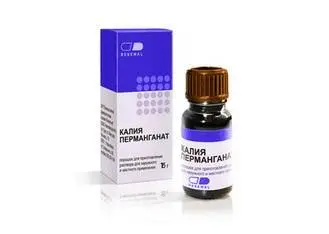
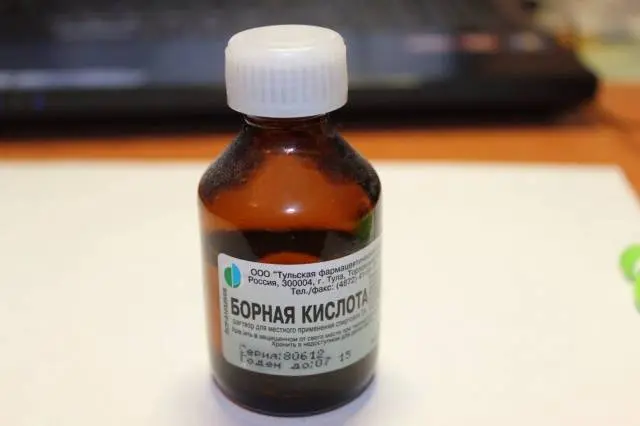
To treat tomatoes from phytophthora, a pink solution of potassium permanganate is being prepared. They spray the plants from top to bottom.
You can safely process tomatoes against late blight with pharmaceutical preparations without worrying about the quality of the fruit. Solutions of iodine, brilliant green, potassium permanganate and boric acid must be alternated for greater effect. Processing of tomatoes from phytophthora can be carried out in a week or ten days. In addition to destroying fungal spores, this treatment increases the taste of tomatoes and their keeping quality.
Soil treatment and greenhouses
Spraying only tomatoes from phytophthora will not give the desired effect, since the spores of the fungal disease calmly overwinter in the open field, in the greenhouse. To be sure that late blight does not cause the death of the tomato crop, a global attack on the fungus is needed.
What should be done to get rid of phytophthora? First of all, before planting tomato seedlings, tillage is carried out on prepared beds in the garden or in the greenhouse. For this purpose, you can use copper sulfate, Fitosporin-M or Arilin. If there are no such funds, you can shed the soil with hot water with potassium permanganate and close the greenhouse.
Secondly, it will be necessary to wash the surface of the greenhouse with any detergent.
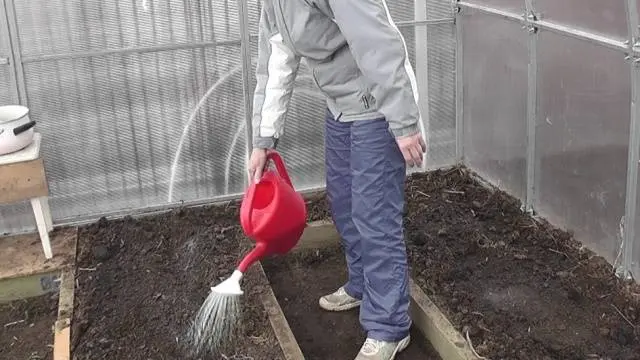
Some gardeners fumigate the greenhouse with pieces of natural wool: they put it on the coals and close the room for a day. You can use smoke bombs. They also destroy fungal spores. Phytophthora spores and the smell of iodine are afraid. You can put points at a distance of 50 cm throughout the greenhouse. You can spray with Baikal EM or Fitosporin preparations.
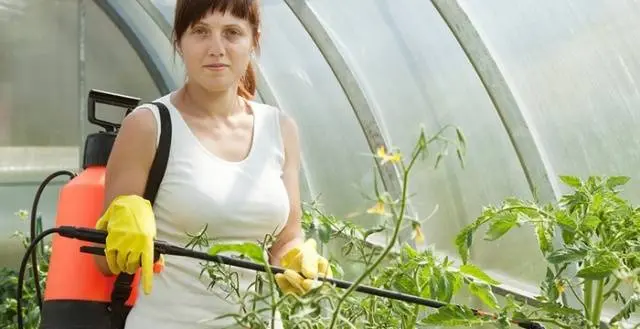
After work, wash exposed parts of the body with warm water and soap.
Tomato processing rules
Tomatoes growing in a greenhouse and open ground are subject to treatment from phytophthora by selected means. The rules are almost the same:
- Processing is carried out early in the morning before sunset.
- Plants are sprayed from all sides.
- The solution must be diluted exactly according to the instructions.
But there is also a difference in air humidity: in the greenhouse it is much higher, and this is a favorable environment for phytophthora, so processing is carried out more often in the greenhouse.
You need to choose calm weather so that the drops of the product do not scatter around, but fall on the tomatoes.
Features of processing tomatoes from phytophthora in closed ground:
Useful Tips
- Do not plant tomatoes in the same place where potatoes or other nightshades were grown last year. And planting tomatoes next to potatoes is not recommended.
- If there is a lot of lime in the soil, add peat, compost, sand.
- Sow green manure in autumn or early spring in place of future plantings of tomatoes.
- Observe agricultural standards when planting and growing vegetables.
- Do not neglect the rules of crop rotation.
- Water the plants in the morning, then most of the water will have time to go into the soil, evaporation will be less.
- If tomatoes are grown indoors, do not forget to ventilate the greenhouse.
- The lower leaves on the tomatoes must be cut off so that there is no thickening, the air can circulate freely.
- If the weather is cloudy, keep watering to a minimum. In this case, perform “dry” watering – loosening. The drip irrigation system showed itself well in the fight against late blight of tomatoes.
- Spraying with drugs, as well as top dressing, should be regular.
- Purchase tomato seeds that practically do not suffer from late blight.
- Do not try to immediately use chemicals to process vegetables, first try folk remedies.
To summarize
Growing a good crop of tomatoes for beginners is simple and difficult at the same time. You need to know a lot of secrets in the care of culture. Don’t be shy about asking for advice from people with rich experience. At one time, they also encountered tomato diseases, including late blight.
If you follow our recommendations, carefully monitor the plantings, then we assure you that you will get healthy and tasty tomatoes. You should not despair if you have not completely managed to defeat late blight. You can try other methods next year. The main thing is to influence the disease from the first minutes of occurrence. Perhaps you yourself will be able to invent your own methods of dealing with late blight spores. Don’t forget to report them.










